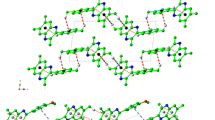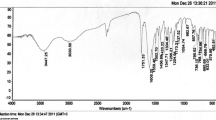Abstract
Density functional theory approaches are employed to elucidate the structural features and electronic properties of cis-dioxidomolybdenum(VI) complexes with water, 8-hydroxyquinoline and 4-benzoyl-3-methyl-1-phenyl-2-pyrazolin-5-one. Geometrical parameters are optimized using B3PW91, B3LYP functionals in conjunction with def2-TZVP, LanL2DZ and 6-311 + G basis sets. Computed results show that the complex energetically prefers a pseudo-pentagonal bipyramidal shape in the ground state. The nature of intramolecular interactions between Mo(VI) and ligands is evaluated by analyzing the natural bond orbital and quantum theory of atoms in molecules. The Mo–OH2 interaction is rather weak with an average distance of 2.445 Å and a very low Mayer bond order of 0.235. The vibrational signatures and vertical electronic transitions of some excitations are examined and compared to available experimental data. The most favorable sites for electrophilic, nucleophilic attack or protonation were also identified using the noncovalent interaction method.






Similar content being viewed by others
References
Turmanova S, Vassilev K (2012) Molybdenum complexes: structure, properties and applications. In: Ortiz M, Herrera T (eds) Molybdenum: characteristics, production, and applications. Nova Science Publishers, New York
Fernandez L, Perez-Pla FF, Tuñón I, Llopis E (2016) DFT Study on the Interaction of Tris(benzene-1,2-dithiolato)molybdenum complex with water a hydrolysis mechanism involving a feasible seven-coordinate aquomolybdenum intermediate. J Phys Chem A 120:9636–9646. https://doi.org/10.1021/acs.jpca.6b10233
Han Y, Huynh HV (2011) Pyrazolin-4-ylidenes: a new class of intriguing ligands. Dalton Trans 40:2141–2147. https://doi.org/10.1039/c0dt01037e
Álvarez M, Galindo A, Pérez PJ, Carmona E (2019) Molybdenum and tungsten complexes with carbon dioxide and ethylene ligands. Chem Sci 10:8541–8546. https://doi.org/10.1039/C9SC03225H
Huang H, Hughes RP, Rheingold AL (2011) Synthesis and structural characterization of group 6 transition metal complexes with terminal fluoromethylidyne (CF) ligands a DFT/NBO/NRT comparison of bonding characteristics of terminal NO, CF and CH Ligands. Dalton Trans 40:47–55. https://doi.org/10.1039/c0dt01006e
Rayati S, Rafiee N, Wojtczak A (2012) cis-Dioxo-molybdenum(VI) Schiff base complexes: synthesis, crystal structure and catalytic performance for homogeneous oxidation of olefins. Inorg Chim Acta 386:27–35. https://doi.org/10.1016/j.ica.2012.02.005
Erickson AN, Brown SN (2018) Molybdenum(vi) tris(amidophenoxide) complexes. Dalton Trans 47:15583–15595. https://doi.org/10.1039/C8DT03392G
Zhao Z, Dai X, Li C, Wang X, Tian J, Feng Y, Xie J, Ma C, Nie Z, Fan P, Qian M, He X, Wu S, Zhang Y, Zheng X (2020) Pyrazolone structural motif in medicinal chemistry: retrospect and prospect. Eur J Med Chem 186:111893. https://doi.org/10.1016/j.ejmech.2019.111893
Da Costa L, Scheers E, Coluccia A, Casulli A, Roche M, Di Giorgio C, Neyts J, Terme T, Cirilli R, La Regina G, Silvestri R, Mirabelli C, Vanelle P (2018) Structure-based drug design of potent pyrazole derivatives against rhinovirus replication. J Med Chem 61:8402–8416. https://doi.org/10.1021/acs.jmedchem.8b00931
Marchetti F, Pettinari R, Pettinari C (2015) Recent advances in acylpyrazolone metal complexes and their potential applications. Coord Chem Rev 303:1–31. https://doi.org/10.1016/j.ccr.2015.05.003
Marchetti F, Pettinari C, Pettinari R (2005) Acylpyrazolone ligands: synthesis, structures, metal coordination chemistry and applications. Coord Chem Rev 249:2909–2945. https://doi.org/10.1016/j.ccr.2005.03.013
Tabassum R, Ashfaq M, Oku H (2021) Current pharmaceutical aspects of synthetic quinoline derivatives. Mini Rev Med Chem 21:1152–1172. https://doi.org/10.2174/1389557520999201214234735
Oliveri V, Vecchio G (2016) 8-Hydroxyquinolines in medicinal chemistry: a structural perspective. Eur J Med Chem 120:252–274. https://doi.org/10.1016/j.ejmech.2016.05.007
Matada BS, Pattanashettar R, Yernale NG (2021) A comprehensive review on the biological interest of quinoline and its derivatives. Bioorg Med Chem 32:115973. https://doi.org/10.1016/j.bmc.2020.115973
Mir JM, Vishwakarma PK, Roy S, Maurya RC (2018) Quinoline and pyrazolone functionalized cis-dioxomolybdenum(VI) complexes: synthesis, hyphenated experimental-DFT studies and bactericidal implications. J Coord Chem 71:3860–3873. https://doi.org/10.1080/00958972.2018.1530767
Shen AY, Wu SN, Chiu CT (1999) Synthesis and cytotoxicity evaluation of some 8-hydroxyquinoline derivatives. J Pharm Pharmacol 51:543–548. https://doi.org/10.1211/0022357991772826
Paljk Š, Klofutar C, Krašovec F, Suhač M (1975) Dissociation of 8-hydroxyquinoline and its 5-chloro- and 5-nitro-derivatives in aqueous solutions. Microchim Acta 64:485–492. https://doi.org/10.1007/BF01219217
Atanassova M, Kurteva V, Lubenov L, Varbanov S, Billard I (2015) Are fancy acidic or neutral ligands really needed for synergism in ionic liquids? A comparative study of lanthanoid extraction in CHCl3 and an ionic liquid. New J Chem 39:7932–7941. https://doi.org/10.1039/C5NJ00777A
Hossain MK, Köhntopp A, Haukka M, Richmond MG, Lehtonen A, Nordlander E (2020) Cis- and trans molybdenum oxo complexes of a prochiral tetradentate aminophenolate ligand: Synthesis, characterization and oxotransfer activity. Polyhedron 178:114312. https://doi.org/10.1016/j.poly.2019.114312
Liu H-Y, Yin Y-S, Yang L-J, Zou X-L, Ye Y-F (2020) Oxidovanadium(V) and dioxidomolybdenum(VI) complexes of N′-(3,5-dichloro-2-hydroxybenzylidene)-4-fluorobenzohydrazide: synthesis, characterization crystal structures and catalytic property. Acta Chimica Slovenica 67(1):130–136
Bibal C, Daran J-C, Deroover S, Poli R (2010) Ionic Schiff base dioxidomolybdenum(VI) complexes as catalysts in ionic liquid media for cyclooctene epoxidation. Polyhedron 29:639–647. https://doi.org/10.1016/j.poly.2009.09.001
Liu S, Amaro-Estrada JI, Baltrun M, Douair I, Schoch R, Maron L, Hohloch S (2021) Catalytic deoxygenation of nitroarenes mediated by high-valent molybdenum(VI)–NHC complexes. Organometallics 40:107–118. https://doi.org/10.1021/acs.organomet.0c00352
Hossain MK, Schachner JA, Haukka M, Lehtonen A, Mösch-Zanetti NC, Nordlander E (2017) Dioxidomolybdenum(VI) and -tungsten(VI) complexes with tripodal amino bisphenolate ligands as epoxidation and oxo-transfer catalysts. Polyhedron 134:275–281. https://doi.org/10.1016/j.poly.2017.04.036
Maurya MR, Uprety B, Avecilla F (2016) Dioxidomolybdenum(VI) complexes of tripodal tetradentate ligands for catalytic oxygen atom transfer between benzoin and dimethyl sulfoxide and for oxidation of pyrogallol. Eur J Inorg Chem 2016:4802–4813. https://doi.org/10.1002/ejic.201600694
Wadt WR, Hay PJ (1985) Ab initio effective core potentials for molecular calculations. Potentials for main group elements Na to Bi. J Chem Phys 82:284–298. https://doi.org/10.1063/1.448800
Hay PJ, Wadt WR (1985) Ab initio effective core potentials for molecular calculations. Potentials for the transition metal atoms Sc to Hg. Journal Chem Phys 82:270–283. https://doi.org/10.1063/1.448799
Hay PJ, Wadt WR (1985) Ab initio effective core potentials for molecular calculations. Potentials for K to Au including the outermost core orbitals. J Chem Phys 82:299–310. https://doi.org/10.1063/1.448975
Bühl M, Reimann C, Pantazis DA, Bredow T, Neese F (2008) Geometries of third-row transition-metal complexes from density-functional theory. J Chem Theory Comput 4:1449–1459. https://doi.org/10.1021/ct800172j
Frisch MJ et al (2010) Gaussian 09 revision C.01, Gaussian Inc. Wallingford CT., Computer Program.
Lu T, Chen F (2012) Multiwfn: a multifunctional wavefunction analyzer. J Comput Chem 33:580–592. https://doi.org/10.1002/jcc.22885
Hanna SY, Shandala MY, Khalil SM (2004) Solvent effects on OH stretching frequencies for 3-arylallyl alcohols. Z Naturforschung Teil A 59:804–808. https://doi.org/10.1515/zna-2004-1114
Gonjo T, Futami Y, Morisawa Y, Wojcik MJ, Ozaki Y (2011) Hydrogen bonding effects on the wavenumbers and absorption intensities of the OH fundamental and the first, second, and third overtones of phenol and 2,6-dihalogenated phenols studied by visible/near-infrared/infrared spectroscopy. J Phys Chem A 115:9845–9853. https://doi.org/10.1021/jp201733n
Kolesov BA (2021) IR and Raman spectra of strong OHO hydrogen bonds. J Mol Struct 1233:130093. https://doi.org/10.1016/j.molstruc.2021.130093
Andruniów T, Jaworska M, Lodowski P, Zgierski MZ, Dreos R, Randaccio L, Kozlowski PM (2008) Time-dependent density functional theory study of cobalt corrinoids: electronically excited states of methylcobalamin. J Chem Phys 129:85101. https://doi.org/10.1063/1.2956836
Lozano JM, Clark DL, Conradson SD, Den Auwer C, Fillaux C, Guilaumont D, Webster Keogh D, Mustre de Leon J, Palmer PD, Simoni E (2009) Influence of the local atomic structure in the X-ray absorption near edge spectroscopy of neptunium oxo ions. Phys Chem Chem Phys 11:10396–10402. https://doi.org/10.1039/B911731H
Chen M, Waghmare UV, Friend CM, Kaxiras E (1998) A density functional study of clean and hydrogen-covered α-MoO3(010): electronic structure and surface relaxation. J Chem Phys 109:6854–6860. https://doi.org/10.1063/1.477252
Liu J, Zhao H, Fan X, Zhang Y (2021) Investigation on formation mechanisms of methanol during cellulose insulation aging based on molecular dynamics simulation. IEEE Access 9:6890–6898. https://doi.org/10.1109/ACCESS.2020.3041555
Alhameedi K, Karton A, Jayatilaka D, Thomas SP (2018) Bond orders for intermolecular interactions in crystals: charge transfer, ionicity and the effect on intramolecular bonds. IUCrJ 5:635–646. https://doi.org/10.1107/S2052252518010758
Bader RFW (1990) Atoms in molecules - a quantum theory. Oxford University Press, Oxford, UK
Bayat M, Yaghoobi F, Salehzadeh S, Hokmi S (2011) A theoretical study on the interaction of [Al(H2O)6]3+ and [Mg(H2O)6]2+ cations with fullerene (C60), coronene and benzene π-systems. Polyhedron 30:2809–2814. https://doi.org/10.1016/j.poly.2011.08.017
Nkungli NK, Ghogomu JN (2017) Theoretical analysis of the binding of iron(III) protoporphyrin IX to 4-methoxyacetophenone thiosemicarbazone via DFT-D3, MEP, QTAIM, NCI, ELF, and LOL studies. J Mol Model 23:1–20. https://doi.org/10.1007/s00894-017-3370-4
Espinosa E, Molins E, Lecomte C (1998) Hydrogen bond strengths revealed by topological analyses of experimentally observed electron densities. Chem Phys Lett 285:170–173. https://doi.org/10.1016/S0009-2614(98)00036-0
Van Der Waals Radius of the elements, Mathematica’s ElementData Function from Wolfram Research, Inc. (n.d.). https://periodictable.com/Properties/A/VanDerWaalsRadius.an.html (accessed October 29, 2021).
Bader RFW (1991) A quantum theory of molecular structure and its applications. Chem Rev 91:893–928. https://doi.org/10.1021/cr00005a013
Popelier PLA, Popelier P (2000) Atoms in molecules: an introduction. Prentice Hall, Hoboken
Jeffrey GA, Jeffrey GA (1997) An introduction to hydrogen bonding. Oxford University Press, New York
Grabowski SJ (2006) Hydrogen bonding: new insights. Springer, Dordrecht
Contreras-García J, Yang W, Johnson ER (2011) Analysis of hydrogen-bond interaction potentials from the electron density: integration of noncovalent interaction regions. J Phys Chem A 115:12983–12990. https://doi.org/10.1021/jp204278k
Johnson ER, Keinan S, Mori-Sánchez P, Contreras-García J, Cohen AJ, Yang W (2010) Revealing noncovalent Interactions. J Am Chem Soc 132:6498–6506. https://doi.org/10.1021/ja100936w
Saleh G, Gatti C, Lo Presti L, Contreras-García J (2012) Revealing non-covalent interactions in molecular crystals through their experimental electron densities. Chem Eur J 18:15523–15536. https://doi.org/10.1002/chem.201201290
Humphrey W, Dalke A, Schulten K (1996) VMD: visual molecular dynamics. J Mol Gr 14:33–38. https://doi.org/10.1016/0263-7855(96)00018-5
Grimmel SA, Reiher M (2019) The electrostatic potential as a descriptor for the protonation propensity in automated exploration of reaction mechanisms. Faraday Discuss 220:443–463. https://doi.org/10.1039/C9FD00061E
Murray JS, Sen K (1996) Molecular electrostatic potentials: concepts and applications. Elsevier, Amsterdam
Acknowledgements
Nguyen Thi Ai Nhung thanks Prof. Dr. Gernot Frenking for allowing the continuous use of her own resources within Frenking’s group. The program used in the study was operated by Reuti (Thomas Reuter) at the Philipps Universität Marburg, Germany.
Author information
Authors and Affiliations
Corresponding authors
Ethics declarations
Conflict of interest
There are no potential conflict of interest by the authors.
Additional information
Publisher's Note
Springer Nature remains neutral with regard to jurisdictional claims in published maps and institutional affiliations.
Supplementary Information
Below is the link to the electronic supplementary material.
Rights and permissions
About this article
Cite this article
Nguyen, H.T., Bui, T.Q., Nhat, P.V. et al. A DFT study of the molecular and electronic structures of cis-dioxidomolybdenum (VI) complex of 8-hydroxyquinoline and 4-benzoyl-3-methyl-1-phenyl-2-pyrazolin-5-one with water. Theor Chem Acc 141, 10 (2022). https://doi.org/10.1007/s00214-022-02868-8
Received:
Accepted:
Published:
DOI: https://doi.org/10.1007/s00214-022-02868-8




